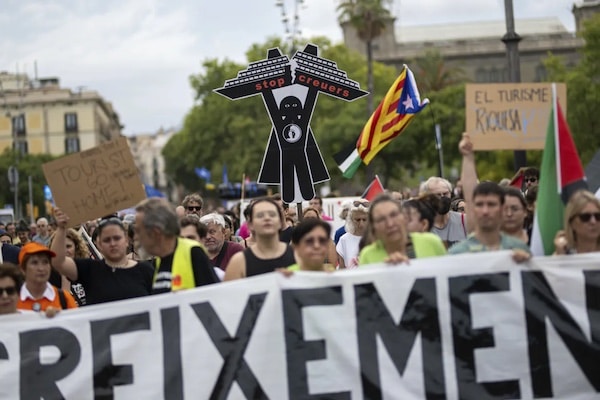The development of tourism in Spain was an initiative launched by Franco as early as the 1950s, to boost the economy and break the country’s isolation under his regime. In the following decades, building speculation, the advent of low-cost flights and the redesign of cities for the use and consumption of the tourist industry have led to a real boom, amplified by major events such as the 1992 Barcelona Olympics. The massive investments that followed the 2008 financial crisis and the spread of short-term rentals have now turned tourism into a tsunami, leading to such strong reactions at the social level that demonstrations against overtourism are now taking place on a weekly basis.
In Mallorca, on July 21, 20,000 people protested against the uncontrolled influx of tourists that has caused a collapse in quality of life, a jump in housing prices, a rise in the cost of basic necessities and the spread of seasonal and precarious employment. For example, hotel cleaning workers are complaining of an increase in workloads that is not matched by an increase in wages. In a demonstration called by the “Less Tourism, More Life” group, the protesters marched behind a banner with the message “Let’s change course, let’s put limits on tourism,” demanding urgent and concrete measures. Compared to a local population of 1.2 million, 20 million tourists are expected to come to the Balearic Islands this year, making Mallorca the third-most-popular destination in Spain after Madrid and Barcelona.
On May 25, tens of thousands of people protested under the slogan “Mallorca is not for sale.” In early July, hundreds of people symbolically occupied some beaches, making oblivious sunbathers keenly aware of the discomfort of residents who, expelled from public spaces, are denouncing the environmental and cultural devastation caused by a tourism industry that aims for endless growth. Everywhere now, local groups are calling for a “tourist degrowth” that would start with a drastic reduction in short-term rentals, a decrease in low-cost flights and cruise ship stopovers, and the disincentivization of home purchases by nonresidents.
The tourism lobby is defending the sector, which, according to their numbers, accounted for 71 percent of the real growth of the Spanish economy in 2023. However, while tourism does represent a crucial item of Spain’s GDP, much of the wealth produced ends up in the hands of a few, often located thousands of miles away, enriching investment funds and entrepreneurs unconcerned with the spillover effects on the inhabitants of trendy destinations.
Massive mobilizations took place in recent months in the Canary Islands, which, according to local groups, are literally “collapsing socially and environmentally” under the pressure of 10 million annual foreign visitors, in addition to the Spanish tourists from the mainland. The eight islands off the coast of Morocco saw the largest mobilization to date on April 20, with 200,000 people taking to the streets to say “no to the invasion” and to local government policies that aim to double the archipelago’s tourist accommodation capacity, while the population at risk of poverty has reached 34 percent.
In Barcelona, some of the 20,000 protesters who took to the streets on July 6 to denounce the “museification” of the city went as far as to target tourists sitting in bars with water pistols, while slogans such as “Tourist go home” have long been seen on the city’s walls. In Málaga, Andalusia, activists recently sealed the locks of some tourist apartments with silicone as thousands of people marched shouting “We want to live, not survive,” a slogan also used in a protest by the residents of Cadiz. Although many media outlets have attacked the protests for “tourismophobia,” the mobilizations are generally focused on denouncing the role of big business groups and a voracious and extractive model of tourism rather than accusing tourists themselves. On July 13, it was the turn of the residents of Alicante (in the Valencia region) to take to the streets, fed up with the 100 cruise ships disembarking hundreds of thousands of tourists on top of the 17 million who visit the province each year, where housing prices have more than doubled in just five years.
The pressure from tourism has become so unbearable that it has also sparked protests in the north of the country, a destination for luxury tourism fleeing the torrid summers of the Mediterranean. A few years ago, the Basque city of Donostia on the Atlantic Coast mobilized against the spread of tourist lodgings and hotels and the destruction of its architectural and natural heritage. Now Bilbao has also joined the fight: a number of tenants’ union activists chained themselves to the doors of a tourist apartment, while the local firefighters, in solidarity with their protest, refused to remove them.
In nearby Cantabria, people are protesting against the touristification of many rural towns and the record increase in housing prices, which jumped 33 percent in 2023 alone. In Laredo, 10,000 people marched against the Ribamontán del Mar urban development project, which includes the construction of luxury apartments and a golf course. In some cases, local governments are beginning to recognize the need for sustainable tourism, but concrete measures are rare. The central government has limited itself to asking the regions to pass regulations to bring order to the regulatory Wild West and has promised to set up a central register of tourist lodgings in 2025.
The Catalan Socialist Party voted against a regional law intended to regulate seasonal rentals, which would have been used to legalize unlicensed tourist apartments. Barcelona’s anti-gentrification local groups remain doubtful that Socialist Mayor Collboni will keep his promise to cancel 10,000 licenses for tourist accommodations by 2028 and to restrict the landing of cruise ships.
Originally published at https://ilmanifesto.it/spagna-la-rivolta-dei-residenti-basta-turismo-selvaggio on 2024-07-28

